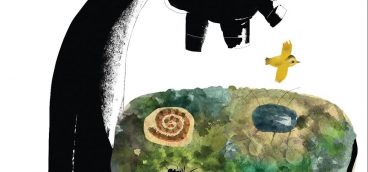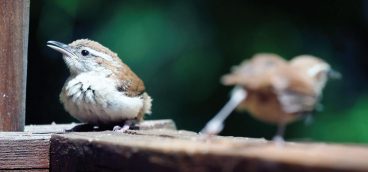The Common Snapping Turtle
“I think it is a rule that people inevitably destroy what they do not understand.” —Wendell Berry

Image: Stacy Innerst
September 20, 2023
Each spring before my first real swim, I stand at the house and gaze downhill to the pond. (I have dipped every month of the year, but that doesn’t count as a real swim.) I scan the water’s surface, looking for snapping turtles. I see them when they come up for air — their little nostrils, at the tip of their snouts, acting as snorkels. I don’t know if they overwintered in the mud at the bottom of the pond or made their way across land, but I always hope they aren’t there.
They always are.
Maybe if I’m quiet and they don’t see me, they won’t bother me, I think. Towel in hand, I tiptoe to the pond, but no matter how stealthily I creep, they see me every time before I’m halfway there. Then they swim away as fast as their prehistoric legs can muster — the only proof of their presence is the ripples they leave behind.
All they ask of me, of any human, is to be left alone.
I haven’t always done so.
When we first moved to the farm, I believed the myths about snapping turtles. That they’d bite off my toes or fingers while I swam in the pond. Snatch the mallard ducklings from the water’s surface, drag them under, and gobble them up. I was so afraid that I allowed a farmer neighbor to catch a snapping turtle and make turtle soup. I’ve caught turtles, too — by dangling chicken necks attached to empty milk jugs floating atop the water — and relocated them to new homes.
That’s when it hissed and its powerful jaws lashed out at me. Who can blame it? I had taken this ancient creature, which has been roaming the earth for about 90 million years and can live to be 100, away from its home and family. I am ashamed to write this.
I’m not the only one afraid of what lurks in the muck. Over the years I’ve had to coax countless people into the pond with me. What we can’t see in the water’s depths apparently terrifies us. There’s even a word for that: thalassophobia.
What I didn’t know — what none of us knew — was that snapping turtles don’t usually attack in water. They might, if we stepped on one in the muck — which is why I jump off the dock — but in 35 years of swimming in our pond, I’ve never even been brushed by one.
“The vile temperament associated with these reptiles largely results from provocation by human beings, the latter making the situation confrontational,” wrote David Carroll in his book, “The Year of the Turtle.” Snapping turtles attack on land where they’re out of their element and feel threatened by the likes of me. Then they’ll strike. “If cornered, approached or restrained, the turtle will lash out with legendary speed and terrific force, its head and neck becoming lethal weapons,” Carroll said.
Still, contrary to popular belief, they can’t sever a finger, Carroll told me, though they can inflict a pretty good wound.
“Snapping turtles lived more harmoniously with dinosaurs than with humans,” he said.
Snapping turtles look scary. Their carapace — or upper shell — resembles armor. Their necks extend, their jaws are hooked, legs scaly, claws sharp, and tails long. (Their Latin name, Chelydra serpentina, means tortoise snake.) And they are big: usually weighing 10-35 lbs., but can reach 75 lbs. One reason they become aggressive, however, is that despite their size and power, their shells do not fully cover their bodies, as on box turtles, for example. The carapace is large — up to 20 inches in length — but the lower shell, the plastron, is small, so they cannot fully protect themselves.
Snapping turtles may live a long time, but they can take 15 to 20 years to successfully reproduce. Their eggs resemble ping-pong balls with “a white shell so tough that the egg may be bounced on a hard surface without breaking,” according to “Turtles of the United States and Canada,” by Clifford H. Pope. Of the 20 to 60 eggs they lay each year, about 90 percent get eaten. The reason they know I’m walking across the lawn is that they “have great eyesight and can sense vibration through their plastron, which acts as a sounding board,” Carroll said. There’s debate whether snapping turtles hibernate or brumate — the latter meaning that on a warm day, they might wake up, crawl around and have a drink. Whatever it’s called, snapping turtles can go without breathing air for five-and-a-half to six months; instead, they take up oxygen and dispel carbon dioxide from the throat and cloaca.
Reptile expert and iguana specialist Wendy Townsend said that snapping turtles, which are omnivores, are good for the health of our pond. “They consume a lot of vegetation, which helps balance the ecosystem for plants, fish, frogs, birds, insects, and dragonflies, the latter being great consumers of mosquitos,” she said. Snapping turtles keep ponds clean by eating carrion. The Turtle Guardian website describes them as the “turkey-vultures of the lake.” They also eat fish, frogs, snakes — and birds.
So, will they eat all my ducklings?
“That’s just not going to happen,” Townsend said. “It’s really about: Can they catch it?” Most carnivores, she said, won’t expend the energy chasing something they can’t catch. “They’ll eat fish that are wounded — creatures that are slow, injured or lagging behind — if they notice they have a different way of swimming, for instance.”
Carroll agreed. They’ll eat whatever they can get hold of, he said, but “only very rarely capture waterfowl or game fish, contrary to frequent reports.” And, he reminded me: Ducks co-evolved with snapping turtles, and both are still here.
Snapping turtles have a lot of predators too — mostly raccoons and skunks, but also coyotes, mink, crow, and fox. Of the 360 turtle species in the world, 187 are threatened with extinction. Pennsylvania’s snappers are not, but its cousin to the south is: the alligator snapping turtle. The reasons include loss of habitat, pollution, water quality, the pet trade, and human consumption. Warnings now exist not to eat them. “Snapping turtles are what’s called bio-accumulators,” Carroll said, “which means they accumulate pesticides or heavy metals in their flesh.”
Snapping turtles can wander for miles looking for good nesting sites or better habitat, and often end up as roadkill. Townsend urges people to get snapping turtles off the road in any way possible. But be careful. The best way to pick up a turtle is at the back of the shell or by the thighs, but not by the tail, which used to be recommended. The tail is an extension of the vertebrae and can become dislocated that way. Carroll believes snapping turtles map their home territories with an internal compass, so never turn a turtle around. They know in which direction they want to go.
I mentioned to a friend over dinner that I was writing about snapping turtles and that I was sorry I’d caught and relocated them. Why, are they endangered, he asked? No, I said. Why feel bad, then; they are nasty creatures. How did he know that? I asked. Because in summer camp, he used to poke them with boat oars.
I have thought about that exchange many times since. In Canada, the common snapping turtle is of special concern and, in 2017, the Ontario government banned the hunting of snapping turtles. Can the U.S. be far behind? We can’t wait until they are threatened to rally around them; we need to rally around all creatures that live among us.
“Snapping turtles have remarkably adapted to whatever the planet throws at them,” Carroll said. “They even survived the big asteroid.”
But will they survive us?













